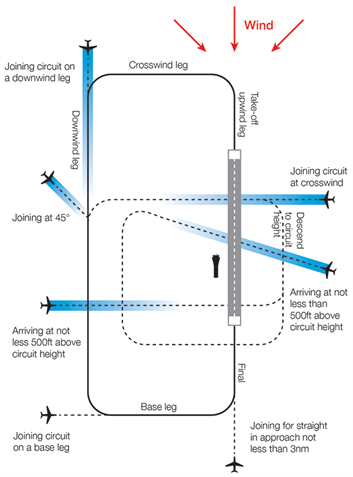Moorabbin Airport Circuit Training
Circuit training is the first stage of practical pilot training focused on take-offs and landings. It involves the pilot making approaches to the runway or helipad, touching down and then applying power to take off again. This is undertaken in accordance with Civil Aviation Safety Authority (CASA) Regulations which are consistent with international practices.
How circuits are conducted
A training circuit consists of five legs – take-off, crosswind, downwind, base and final approach to the runway.
Aircraft take off into the wind, climb to 500 feet and then turn onto the crosswind leg. They continue to ascend to 1000 feet and turn onto the downwind leg. Having turned onto the base leg the descent commences. After turning onto the final leg and lining up with the runway the aircraft will touch down and take off again.

Helicopters circuit inside the fixed wing circuit at a lower altitude.
The majority of circuits are performed on the eastern side of the airport while arrivals and departures operate from the western side.
“Left-hand” circuits will be conducted when Runway 17 Left is being used, and “right-hand” circuits when Runway 35 Right is used. For left-hand circuits, the pilot turns left after take-off and flies anticlockwise. For right-hand circuit, the pilot turns right and flies in a clockwise direction.
A simplified representation of a left-hand circuit is shown at right. The take off and final stage of the circuit is flown into the wind, as this is the safest way for an aircraft to operate. The aircraft symbols and dotted lines indicate recommended ways for an aircraft to join the circuit pattern. Click the image to enlarge it, and use your browser “Back” button to return to this page.
Moorabbin Airport’s voluntary Fly Friendly Program asks tenants and airport users to keep circuits as tight as possible. However, because the student pilots performing circuits are so new to flying, this is not always achievable.
More information about circuit training is found here.
Animation of the Moorabbin circuit
The animated aircraft below and the static tracks shown in blue are created from actual tracks flown by aircraft in the circuit. This illustrates the degree of variation that will occur in the way student pilots fly circuits. The altitudes above mean sea level of the aircraft are also shown.
You can enlarge to full-screen by clicking the square-shaped button in the bottom right-hand corner of the player.
To replay the animation press the “Replay” button in the bottom left-hand corner of the player.
Effects of runway direction
Air traffic control will determine which runways are used at any given time depending on the direction of the wind – this is because aircraft must generally take off and land into the wind for safety reasons. Depending on which runway direction is in use, different suburbs will be affected by different legs of the circuit.
The Noise Complaints and Information Service tends to receive more complaints from suburbs under the crosswind and base legs of the circuit. This is the case at all airports where circuit training occurs. When the north-south runways are being used in a northerly direction (Runways 35 Left and Right), parts of Heatherton and Dingley Village will be affected by the crosswind leg and Braeside and Mordialloc will be affected by the base leg. The opposite is true when these runways are being used in a southerly direction (Runways 17 Left and Right).
Similarly, when the north-west – south-east runways are used in a northerly direction (Runways 31 Left and Right), Heatherton is affected by the crosswind leg and Dingley Village and Braeside by the base leg with the opposite effect when the runways are used in a southerly direction (Runways 13 Left and Right).
Circuit Training hours
Training during both day and night is important for developing pilot competencies, as is experience with using different types of navigational aids.
Circuit training times for Moorabbin Airport are:
Non-daylight saving periods:
Monday to Friday: 8:00am – 9:00pm
Weekends: 9:00am – 6:00pm or last light, whichever is sooner
Daylight saving periods:
Monday to Friday: 8:00am – 10:00pm
Weekends: 9:00am – 6:00pm or last light, whichever is sooner
Please note that these times above apply only to circuit training, and not to arriving and departing aircraft which may operate 24 hours a day. It is important to note that when aircraft are arriving outside control tower hours they are required to fly a circuit before landing for safety reasons. Therefore it may seem like aircraft are flying circuits outside hours when this is not the case.
There are only two lit runways, Runway 13 Left/35 Right and Runway 17 Left/31 Right. This means these runways must be used for night circuits. In turn, this means that all night circuits will take place to the east of the airport. Due to flying training courses running on different schedules, some nights will have multiple aircraft operating and other nights none at all.
Altitudes
Select a quarter to see charts showing a breakdown of which side of the airport circuits were conducted in that period. The breakdowns are shown as percentages rather than total counts. This is because the source radar data for Moorabbin Airport has gaps due to the radar being located at Melbourne Airport. As these gaps occur randomly throughout the day, the data, while incomplete, provides a representative picture of the distribution of circuits.


